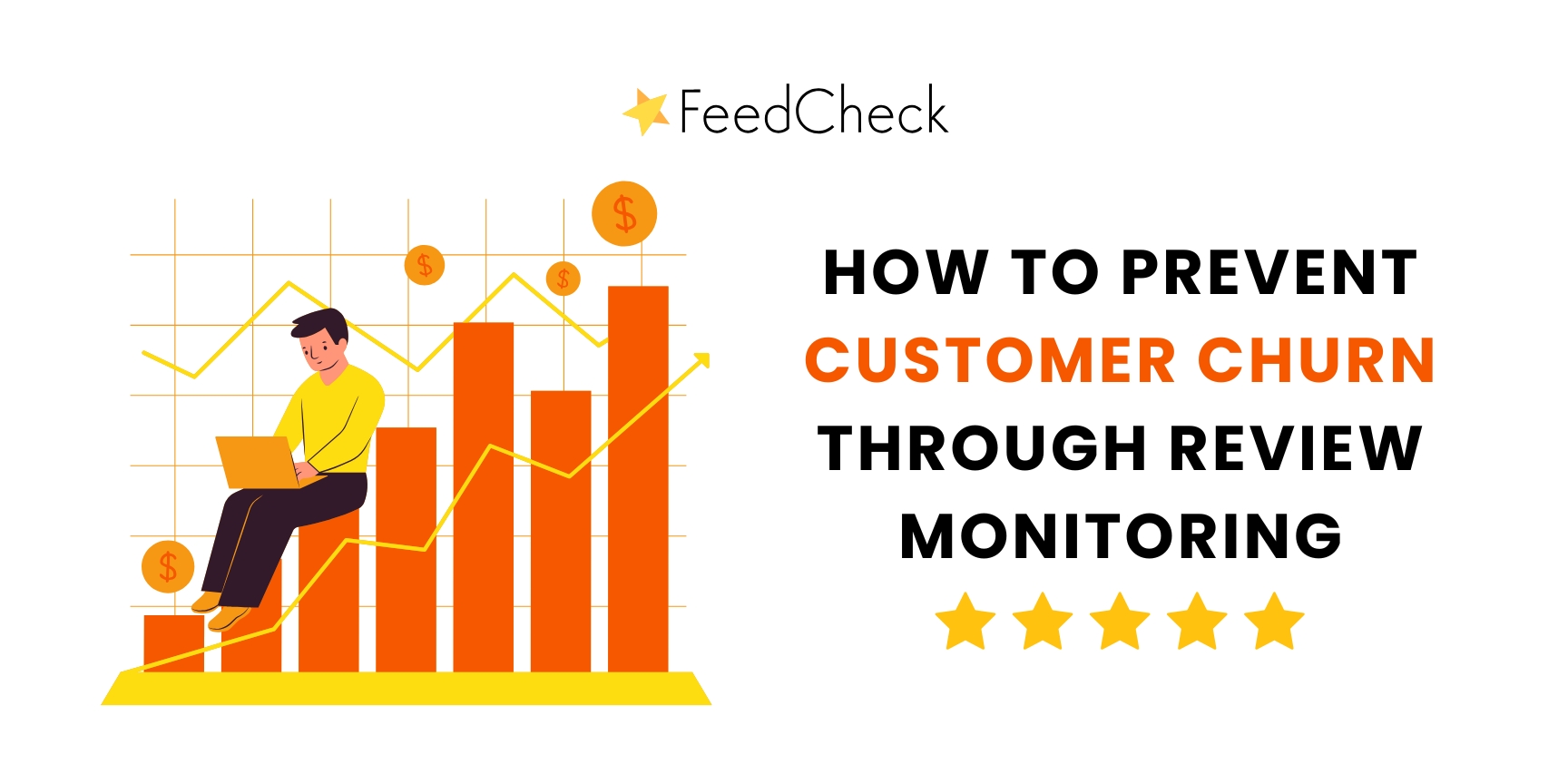What is customer churn?
Customer churn happens when customers stop doing business with a company, be it no longer buying a product, unsubscribing from a service provider, or switching to a different company. It is a percentage of customers who, for various reasons, decide to leave.
For online reputation management for brands, customer churn is critical – think of it like a health check for finding out how happy your customers are.
Unfortunately, churn rate is inevitable, but some industries may be affected more than others. The wholesale and consumer packaged goods industries face the highest churn rate at 56% and 40% respectively, according to CustomerGauge. As much of a sad metric as it may be, customer churn provides a hard truth about retention rates and it can signal underlying issues that require the company’s attention.
Reducing churn means keeping customers happy and coming back for more. Therefore, understanding customer churn is the first step towards boosting retention and consequently, your brand’s online reputation.
How to calculate churn
Calculating churn is easier to figure out than it may sound: divide the number of customers lost over a specific period by the number of customers you had at the beginning of that time frame. Multiply that by 100 and you get your churn percentage.

A lower churn rate indicates fewer customers leaving, and more customers satisfied – so the closer you are to 0%, the better. Once you have your churn rate, you need to take action. Find out why your customers are leaving and use that information to create preventative strategies to prevent further churn.
For a deeper understanding, try using historical data to forecast churn trends. Customer surveys are another valuable tool – they reveal why customers are leaving to help you identify the root of churn.
Reducing customer churn doesn’t just save revenue – a stable customer base often reflects positively on your brand and it can help you polish your online reputation by showing customers you care about their experience.
What does churn rate mean?
A high churn rate indicates a business is losing a lot of customers, and, more significantly, losing more than it is bringing in.
In this context, something must be going wrong in the company, whether that is low quality products, poor customer service, or other negative factors.
This also signals a gap in your community, a sign that customers aren’t satisfied and are choosing to take their business elsewhere. Reducing churn shows potential customers that your brand is committed to improvement and values the customer experience.
This can go a long way in enhancing your brand reputation, as happy customers are more likely to leave positive reviews and word-of-mouth recommendations.
What causes customers to churn?
It’s difficult to pinpoint exactly why customers leave, but in essence, churn happens when customers feel that their needs aren’t met. It can be due to a mix of product quality, customer service, and brand reputation management. Here are some of the main reasons customers decide to take their business to other companies:
- Disappointing experiences. Customers want to feel valued, so when their experience with a company is not what they were expecting, they are likely to look elsewhere. 67% of customers mention a negative experience as a reason for churn, leading to poor reviews, affecting your brand’s online reputation and, ultimately, pushing new potential customers away.
- Lack of clear communication. Customers need to understand your product – what it is, how to use it, and where to find support if they need help. When communication is lacking in details or is not clear, frustration and anger builds up. This unfortunately leads to both negative reviews and a high churn rate, damaging your brand image.
- Lack of value. Customers want to feel like they’re getting their money’s worth, and if they don’t see clear value in your product, they’ll be tempted to explore other options. This doesn’t necessarily mean lowering your prices – it’s about consistently delivering quality and showcasing the unique benefits of what you have to offer.
- No company engagement. Customer loyalty grows when companies create a community and engage with their customers, even after they have made a purchase. When companies don’t make an effort to follow up or keep customers informed of promotions, trends, and opportunities, their customer base can feel neglected. With 54% of customers expecting companies to provide great customer experiences and satisfaction, brands that stay in touch take the lead, building stronger relationships with their customers and fostering a healthier online reputation.
How can customer review monitoring help prevent consumer churn?
Minimizing customer churn is definitely a challenge, but one way that offers a direct window into what customers are thinking is through online review monitoring.
In simple words, the better you understand your customer’s experiences and preferences, the better you can predict why or when they might leave.
Why does review monitoring matter for retention?
Monitoring reviews helps you identify patterns, understand what matters most to your customers, and what isn’t working out, allowing you to spot any recurring issues.
Diving deep into user behavior and interactions with a brand can provide valuable insights, turning major problems that drive customers away into opportunities for improvement.
Keeping an eye on what your customers are saying and feeling about your brand allows you to show that you’re listening, responding, and making improvements. This helps increase trust and encourages positive interactions with your brand.
The best way to stay connected with your customers is by using a comprehensive online review monitoring tool like FeedCheck. FeedCheck’s product review aggregator can streamline customer feedback into actionable insights, making it easy to track and analyze customer sentiments. Book a demo here to see how we can help your business stay on top of brand review monitoring.

How to get responsive customer feedback
It’s essential to encourage open feedback across channels. Ask for customer’s opinions at different times, like after a purchase or a customer support interaction. The more you encourage feedback, the more insights you’ll have, and the more your customers will feel that their voice is valued.
Getting real-time feedback is crucial if you want to address issues quickly. Set up alerts on your review monitoring tool so you’re notified whenever a new review comes in. This way you’re able to respond to customers and show you care about their experiences, keeping them engaged with your brand.
How to effectively collect and analyze feedback
Collecting and analyzing feedback doesn’t have to be a scary, complex task. Organize your feedback channels in a central system (a.k.a. a review monitoring service) to make it easy to see patterns in customer sentiments.
Be sure to heavily research the good and the bad aspects of your customer’s experiences as explained in reviews. This deep dive can help you track down specific issues that may be leading customers to leave, as well as what customers love most and keeps them coming back.
BrightLocal found that only 3% of consumers said they have ‘never’ read online reviews, so the importance of handling reviews with care becomes obvious: 100 good reviews can easily be overshadowed by a single bad experience from a customer. Building a positive presence all around means addressing all concerns, both publicly and privately, showing customers you’re responsive and attentive.
Building a strong online reputation with customer review monitoring
Proper online review monitoring supports great customer service and, in turn, leads to customer satisfaction and loyalty. Customers are more likely to stay with your brand when you prove trustworthy and committed to providing quality.
By monitoring reviews, responding to feedback, and addressing issues, you’re showcasing your dedication to customer satisfaction. This builds trust, reinforces your reputation, and creates a positive cycle that attracts new customers and retains current ones.
Conclusion
While customer churn is indeed inevitable, your reaction to it can make all the difference. When you understand your customers’ needs and frustrations, you reach a point in which it becomes easier to prevent issues and bad experiences from escalating into customers leaving.
At the same time, you are actively reinforcing your online reputation, and that draws people to your brand. Consistently monitoring reviews, collecting feedback, and addressing concerns shows customers you care about more than just revenue.
At the end of the day, people just want to be heard. And when they feel valued, they are more likely to stick around and share their positive brand experience with others. Embrace every review as a chance to grow, strengthen your online reputation, and keep your customers engaged – one satisfied customer at a time.
FeedCheck provides the tools needed to understand, track, and respond to customer feedback. By aggregating reviews from various platforms, FeedCheck can help brands identify trends and issues, boosting retention and online reputation. Contact us to discover how FeedCheck can help you turn your reviews into opportunities for growth.
